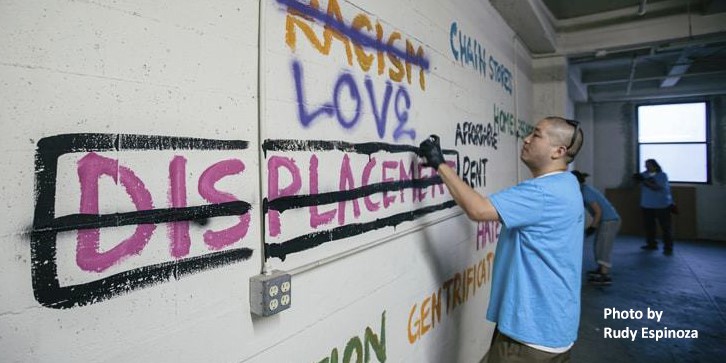José Velasquez has lived in Boston for the past 28 years. In April 2006, he and his family moved into a 14-unit apartment building on Meridian Street in East Boston. The landlord didn't maintain the place very well, but Velasquez was able to take care of some of the repairs and upkeep himself, and the rent increases were manageable. Then new owners took over the building this summer, and Velasquez and all of his neighbors were given 30-day eviction notices — as with many such mass evictions — so their building could be renovated and rented out at a higher market rate.
Most of the building's residents moved out. But Velasquez and his wife, who live with their adult daughter and niece, both of whom require special care, decided to stay and fight. "I've always paid rent on time. I've never failed them. So I feel I have rights," he explained in his native Spanish. A few days after he received the eviction notice, Velasquez connected with other tenants and organizers through City Life/Vida Urbana, a local housing justice organization that helps people facing eviction or rent hikes stay in their homes. So when the #RenterWeekofAction kicked off its nationwide campaign of coordinated direct actions and renter assemblies with a citywide march in Boston on September 16, Velasquez was there.
Resisting gentrification and building renter power
"[At the march] I spoke with the community about the help we need and the role of Vida Urbana. The event was really beautiful," Velasquez recalled. "We need to defend our rights because, if we don't, the rich come to step over us. We need to fight for the well-being of our families." He continued, "The rich are coming to Boston to buy properties, turning them into condominiums and making buildings expensive. But the poor also want to live well and care for our families."
His story is all too common: throughout the United States, as rents rise and wages remain stagnant, a growing number of renters are unable to afford the cost of housing. Boston is no exception.
Renters across the country are being squeezed and displaced," said Darnell Johnson of Right to the City Boston. "While the crisis is worsening, we also believe that renters are beginning to wake up to enormous power we have when organized. At Homes For All, we're supporting communities in organizing tenants unions and neighborhood groups to defend our housing, reclaim our communities, and win community control of land, housing, and development that impacts working-class people."
To address these challenges, Right to the City and its partner organizations are focused on building power among renters — and in Boston, where more than 390,000 people live in renter households, there is plenty to build on. Sixty-five percent of Boston's residents are renters, and after paying their rent and utilities they contribute nearly $7.5 billion to the Boston economy each year.
But in this city, where the economy and the population are both growing, many long-term residents are at risk of displacement. According to a recent National Equity Atlas analysis of housing affordability and the economic impact of burdensome rents in Boston, from 2000 to 2015 median rents in the city increased by 18 percent, while median renter-household incomes actually declined by 11 percent. So it's not surprising that during the same period, the share of renter households who are rent-burdened (spending more than 30 percent of their income on housing costs) jumped from 42 percent to 51 percent.
The financial burden of high rents isn't only a challenge for families who can barely make ends meet; it's also a strain on the local economy. If no Boston renters were housing burdened — if they spent only what they could afford on rent — they would have an extra $764 million to spend in the community each year, with people of color enjoying the largest percentage gains. Latino renters like the Velasquez family would see a 16 percent increase in their annual disposable income (income after paying for rent and utilities), and their Asian or Pacific Islander counterparts would see a 19 percent gain. On average, each rent-burdened household in the city would have an additional $9,300 each year to help cover the costs of necessities like food, transportation, health care, and childcare.
Renter protections can reduce the high costs of displacement
In the context of accelerating gentrification and skyrocketing rents, the City of Boston has taken a two-pronged approach to address housing affordability: One set of strategies focuses on increasing the supply of affordable housing, setting aside millions of dollars to help affordable housing developers compete in the city's fast-moving real estate market for both existing buildings and new development space. Another group of policies aims to help existing tenants stay in their homes.
Yesterday, the city council passed the Jim Brooks Community Stabilization Act, a just cause eviction ordinance that will "help protect residential tenants and former homeowners living in their homes post-foreclosure against arbitrary, unreasonable, discriminatory, or retaliatory evictions" and give the city greater ability to track evictions in real time. Another legislative proposal would give tenants the right of first refusal on foreclosed properties. And city officials are also working to provide incentives to property owners to keep tenants — and rents — stable.
Last year, Mayor Marty Walsh launched the city's Office of Housing Stability (OHS) with an explicit anti-displacement mission to help residents find and maintain affordable housing. As part of its broad anti-displacement agenda, OHS regularly tracks building sales to identify residents who may be at risk for mass eviction, and reaches out to tenants to inform them of their rights. So when OHS staff heard about the clearing out of the building where the Velasquez family lives, they immediately reached out to City Life/Vida Urbana.
"In the case of a no-fault eviction, tenants can get an additional six months — up to a year for elderly or disabled tenants — but we are finding residents agreeing to leave after just six weeks," said Kate Brady, senior program manager at OHS. "Massachusetts has a lot of tenant-friendly protections, but they only work if people know when and how to assert them." That's why OHS is pushing for state-level legislation that would guarantee a right to legal counsel for tenants facing eviction. "With a right to counsel, tenants can rebalance a power imbalance in which the vast majority of landlords have an attorney, but only 6 percent of tenants do," Brady explained.
For many low-income residents, that imbalance is exacerbated by a mix of market forces that drive up property values while driving down workers' economic power. In May of this year, one month before he received his eviction notice, Velasquez, who works in maintenance, asked his employer for a raise after he heard that several of his co-workers had received pay increases. Instead, his hours were cut. "They took one day off my schedule and reduced my pay," he explained. "They said they didn't have money for me but they were hiring other people."
Not long after, to entice Velasquez to give up his apartment, the building's new owners offered to pay him $400 per month for a period of a year — but he knew it wouldn't be enough. "I said no, because if I leave, the other apartments [out there] are too expensive." According to data from, the median market-rate rent for a two-bedroom unit in Boston was $2,400 a month as of July 2017, and Velasquez estimated that even the cheapest places where he could move with his family cost around $1,800. "Right now, I pay $950," he said. "We break even with the current rent, so I couldn't pay double. I just couldn't afford it."
Beyond the family budget, OHS points to the potential public savings in shelter and health-care costs as another incentive to help renters stay in place. "Preventing displacement not only keeps families stable in terms of their work, schools, and communities," explained Lisa Pollack, director of communications for the Department of Neighborhood Development, "the costs savings can be astronomical." Pollack added, "We really need to get farther upstream" to prevent crises rather than just responding to them.
For the tens of thousands of families in Boston struggling to get by, the difference could be life-changing. "Before I learned about Vida Urbana I would just think and cry inside," Velasquez said. "But now I have learned that everyone must defend their rights. Even if you don't speak English and are an immigrant, even the undocumented — we all have rights."



